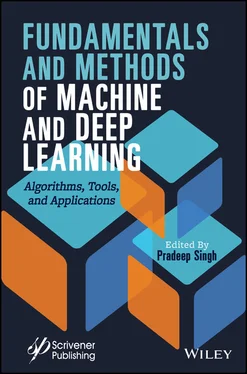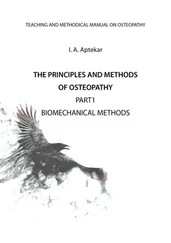Pradeep Singh - Fundamentals and Methods of Machine and Deep Learning
Здесь есть возможность читать онлайн «Pradeep Singh - Fundamentals and Methods of Machine and Deep Learning» — ознакомительный отрывок электронной книги совершенно бесплатно, а после прочтения отрывка купить полную версию. В некоторых случаях можно слушать аудио, скачать через торрент в формате fb2 и присутствует краткое содержание. Жанр: unrecognised, на английском языке. Описание произведения, (предисловие) а так же отзывы посетителей доступны на портале библиотеки ЛибКат.
- Название:Fundamentals and Methods of Machine and Deep Learning
- Автор:
- Жанр:
- Год:неизвестен
- ISBN:нет данных
- Рейтинг книги:5 / 5. Голосов: 1
-
Избранное:Добавить в избранное
- Отзывы:
-
Ваша оценка:
- 100
- 1
- 2
- 3
- 4
- 5
Fundamentals and Methods of Machine and Deep Learning: краткое содержание, описание и аннотация
Предлагаем к чтению аннотацию, описание, краткое содержание или предисловие (зависит от того, что написал сам автор книги «Fundamentals and Methods of Machine and Deep Learning»). Если вы не нашли необходимую информацию о книге — напишите в комментариях, мы постараемся отыскать её.
The book provides a practical approach by explaining the concepts of machine learning and deep learning algorithms, evaluation of methodology advances, and algorithm demonstrations with applications.
Audience
Fundamentals and Methods of Machine and Deep Learning — читать онлайн ознакомительный отрывок
Ниже представлен текст книги, разбитый по страницам. Система сохранения места последней прочитанной страницы, позволяет с удобством читать онлайн бесплатно книгу «Fundamentals and Methods of Machine and Deep Learning», без необходимости каждый раз заново искать на чём Вы остановились. Поставьте закладку, и сможете в любой момент перейти на страницу, на которой закончили чтение.
Интервал:
Закладка:
1.2 Introduction
ML is one of the quickest developing fields in software engineering. A lot of studies have been carried out to make machines smart; learning is one of the human characters which are made as necessary aspects of the machine too. For example, we are standing at a crowded railway station waiting for a friend. As we wait, hundreds of people pass by. Each one looks different, but when our friend arrives we have no problem picking her out of the crowd. Recognizing people’s faces is something we humans do effortlessly, but how would we program a computer to recognize a person? We could try to make a set of rules. For example, our friend has long black hair and brown eyes, but that could describe billions of people. What is it about her that you recognize? Is it the shape of her nose? But can we put it into words? The truth is that we can recognize people without ever really knowing how we do it. We cannot describe every detail of how we recognize someone. We just know how to do it. The trouble is that to program a computer, we need to break the task down into its little details. That makes it very difficult or even impossible to program a computer to recognize faces. Face recognition is an example of a task that people find very easy, but that is very hard for computers. These tasks are often called artificial intelligence or AI. ML is the subset of AI [1]. Earlier data was stored and handled by the companies. For example, each time we purchase a product, visit an official page, or when we walk around, we generate data. Every one of us is not just a generator yet also a buyer of information. The necessities are needed to be assumed also interests are to be anticipated. Think about a supermarket that is marketing thousands of products to millions of consumers either at stores or through the web store. What the market needs is to have the option to predict which client is probably going to purchase which item, to augment deals and benefits. Essentially every client needs to find the best suitable product. We do not know precisely which individuals are probably going to purchase which item. Client conduct changes as expected and by geological area. However, we realize that it is not arbitrary. Individuals do not go to store and purchase things irregular, they purchase frozen yogurt in summer and warm clothes in winter. Therefore, there are definite outlines in the data.
An application of AI strategies to an enormous information base is termed data mining [4, 17]. Data mining is an enormous volume of information handled to develop a basic model with significant use, for instance, having high perspective accuracy. To be insightful, a framework that is in a changing climate ought to be able to learn. If the framework can learn and receive such change, then the framework designer need not anticipate and give answers for every conceivable circumstance. An exact range of effective programs of ML already exists, which comprises classifiers to swot e-mail messages to study that allows us to distinguish between unsolicited mail and non-spam messages. For an immense size of data, the manual foreseeing gives an unpredictable task to individuals. To overthrow this issue, the machine is trained to foresee the future, with the assistance of training and test datasets. For the machine to be trained, different types of ML algorithms are accessible. The computer program is supposed to study from the experience E regarding few classes of task T from performance P extent. The estimated performance of a task improves with experience [8].
ML can be implemented as class analysis over supervised, unsupervised, and reinforcement learning (RL). These algorithms are structured into a taxonomy constructed on the estimated outcome.
Unsupervised learning (UL) is a kind of AI that searches for previously undetected samples in an informational set without prior marks and with the least human management. Cluster analysis and making data samples digestible are the two main methods of UL. SML works under defined instructions, whereas UL works for the unknown condition of the results. The UL algorithm is used in investigating the structure of the data and to identify different patterns, extract the information, and execute the task [12, 15].
R) can be an idea of a hit and a preliminary strategy of knowledge. For each activity performed, the machine is given a reward point or a penalty point. On the off chance that the alternative is right, the machine picks up the prize point or gets a penalty point if there should be an occurrence of an off-base reaction. The RL algorithm is the communication between the atmosphere and the learning specialist [14]. The learning specialist depends on exploitation and exploration. The point at which the learning specialist follows up on experimentation is called exploration, and exploitation is the point at which it plays out an activity-dependent on the information picked up from the surrounding
Supervised learning (SML) algorithms function on unidentified dependent data which is anticipated from a given arrangement of identified predictors [20, 21].
1.3 Supervised Learning
SML is genuinely normal in characterization issues since the aim is to get the computer to get familiar with a created descriptive framework. In SML, the data annotation is termed as a training set, whereas the testing set is unannotated data. When annotations are discrete in the value they are called class labels while the continuous numerical annotations are so-called continuous target values. SML problems are grouped into classification and regression. Classification is the type of SML where the result has discrete value and the aim is to predict the discrete values fitting to a specific class. Regression is the type of SML that is acquired from the labeled datasets and continuous-valued result are predicted for the latest data which is given to the algorithm [8].
In SML, every model is a pair comprising of an input object and the desired output value. SML requires pre-labeled information. For masked occurrences, an ideal situation will take into consideration to accurately calculate and decide the class labels. This requires the taking in algorithms, to sum up from the training data to unobserved states in a “sensible” way. SML algorithm investigates the training data set and produces a derived capacity, which is utilized for planning new models. By this process, the informational set should have inputs and known outputs. SML can be classified into two types: regression and classification [12]. Regression is the sort of SML that studies the labeled datasets and anticipates a persistent output for the new information set to the algorithm. In this method, the required result is in the form of a number. Taking an example, a regression model that decides the cost of a pre-owned vehicle, ought to have numerous instances of used vehicles recently sold. It should essentially know the data sources and the subsequent output to assemble a model. In classification, the algorithm needs to plan the new information that is found in any of the two classes that are present in the dataset. The classes should be planned to one or 0 which is considered as “Yes” or “No”, “snows” or “does not snow”, etc. The result will be both of the classes and not a number as it was in regression. For instance, the classifier decides if an individual has an illness, the algorithm should consist of sources of input and it must be able to predict the outcome.
Some of the known SML algorithms are linear regression, logistic regression, decision tree, support vector machine (SVM), etc. [3].
1.4 Linear Regression (LR)
LR is the simplest method of regression; it is a linear approach to model the link between a scalar response and one or more descriptive variables. Few examples of the LR algorithm are predicting the stock price, exam scores, etc. In other words, it is a statistical regression process used for predictive evaluation, mainly used to solve the regression problem in ML. Assume a model with a linear relationship among the input ( x ) and the single output value ( y ). Precisely that y can be estimated through a linear combination of input ( x ). The input with a single value is referred to as simple LR and input with multiple values is often referred to as multiple LR. For example, consider a linear equation which consolidates a set of ( x ) input variable resulting in a predicted outcome ( y ) for the given set of input. Hence, both the input ( x ) and the output value are numeric. The line equation allows one scaling factor to every input value which is called a coefficient. Another extra coefficient is added, which is often known as the intercept. To learn the LR model is to estimate the coefficient values used in the illustration of available data. Various techniques are to train the data; the most common technique used is ordinary least squares (OLS) [6]. Figure 1.1 characterizes the conspiracy between data points and LR line.
Читать дальшеИнтервал:
Закладка:
Похожие книги на «Fundamentals and Methods of Machine and Deep Learning»
Представляем Вашему вниманию похожие книги на «Fundamentals and Methods of Machine and Deep Learning» списком для выбора. Мы отобрали схожую по названию и смыслу литературу в надежде предоставить читателям больше вариантов отыскать новые, интересные, ещё непрочитанные произведения.
Обсуждение, отзывы о книге «Fundamentals and Methods of Machine and Deep Learning» и просто собственные мнения читателей. Оставьте ваши комментарии, напишите, что Вы думаете о произведении, его смысле или главных героях. Укажите что конкретно понравилось, а что нет, и почему Вы так считаете.












